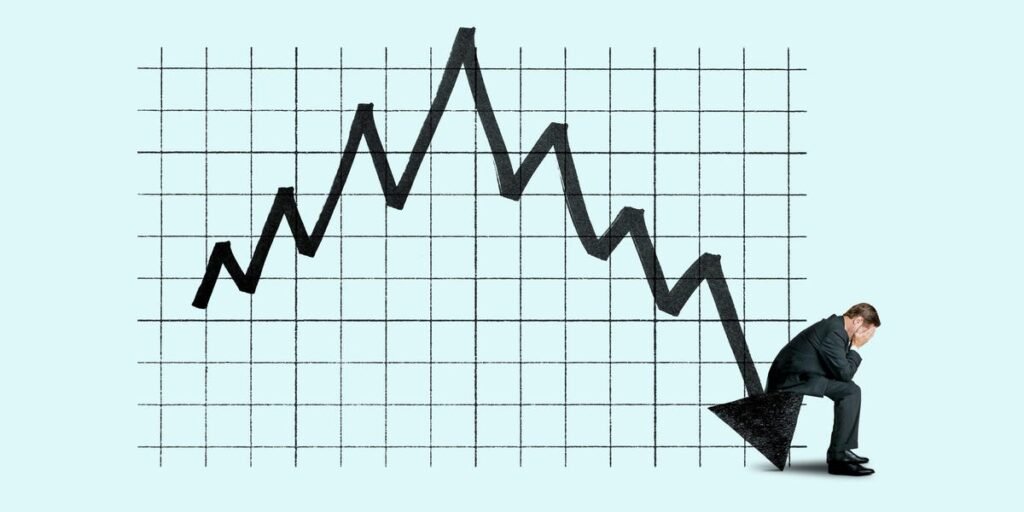It’s a trend experts say will drag on the economy and could take years to fix, mainly because men have already been dropping out of the workforce for decades.
According to Carol Graham, a senior fellow of economic studies at the Brookings Institute, the labor force participation rate of prime working-age men has been declining over the last twenty years. Today, 11% of men aged 25-54 don’t have a job and aren’t looking for one, more than triple the percentage recorded in 1955, when just 3% were out of the workforce, according to data from the Bureau of Labor Statistics.
That amounts to around 7.2 million prime working-age men who aren’t working. That’s introduced a host of problems for the economy, leaving key industries understaffed, and adding to the strain on government services and social safety nets, Graham and other experts told Business Insider.
“Some of them drop out [of college] and are just sort of forlorn and have no purpose or meaning in life. They’re not very likely to be married. They’re very likely to be living in their parent’s basement,” Graham said. “They’re lonely, they’re isolated.”
The economic burden can also compound through generations, she added, given that men who have exited the workforce tend to be lower-income and are more likely to report mental and physical health problems, which impact their children’s ability to build wealth.
Zack Mabel, a research professor at Georgetown University, theorizes that falling labor force participation among young men could impact the economy for at least several decades.
“At this point, it’s a long trend over the course of multiple decades that does not appear to be improving, and could have real long-term consequences,” he said.
Straining the economy
The economy appears to already be feeling the decline in male workforce participation. Despite a small post-pandemic rebound, US GDP per employee fell 1% in 2022, the first decline seen since the World Bank began recording productivity data over 30 years ago.
The overall labor force participation rate, meanwhile, has slumped to 62%. Besides the years following the pandemic, US workforce participation rate hasn’t been that low since the 70s, World Bank data shows.
The trend could weigh on key industries, like infrastructure and manufacturing, where women are often less likely to seek work due to social stigma, Mabel said. That means it could be hard for those industries to find workers, which is a big problem considering the need for labor in growing areas like semiconductors, he added.
“In a situation where you have millions of men … foregoing college, and as a result are less productive and less able to hold onto a stable job, yes, that certainly would raise concerns our national productivity would suffer as a result,” Mabel said.
And while the housing market may be booming now, it is also possible that men leaving the labor force will weigh on that market as well. Meredith Whitney, a longtime Wall Street forecaster, predicts home prices could drop as much as 30% over a period of years thanks to men working less, being less interested in starting families, and being more likely to live with their parents.
Those trends all weigh on household formation, which is the most important factor in determining home prices over the long term, Whitney said.
42% of men who have exited the workforce live with at least one parent, a 2017 Brookings study found.
“This is such a seismic shift in the social structure,” she told BI. “It’s hard to say how long it lasts.”
Government benefits are also hugely taxed by men who are not in the workforce.
Men who have dropped out of the workforce, for one, are significantly more likely to suffer from opioid addiction, Graham said. 44% of men who were out of the workforce said they needed to take pain medication — more than double the portion recorded in employed men, where just 20% took pain meds, a separate Brookings study found.
57% of men not looking for work said they had a physical, mental, or behavioral reason, according to a survey conducted by BPC-Artemis.
11% of men who have exited the labor force rely entirely on government welfare programs for income, according to Brookings data.
“They cost the health system. They go to the emergency room and they’re sick, they’re not going to be able to pay the bills,” Graham said. “That’s coming out of somewhere.”
The welfare burden is exacerbated by the fact that unemployed men aren’t contributing to benefit programs such as through Social Security taxes.
“Potentially, more and more people would benefit and depend on resources that we don’t actually have the means to provide … And that then would really present itself as a huge societal conundrum,” Mabel warned.
There’s no clear answer for how to get young men back into the workforce. The causes appear to be multifold — disabilities, incarceration, and wages not being enticing enough, to name a few —but possible solutions could lie in helping train men for the jobs that are available, according to Graham, or finding ways to give young men role models, such as by hiring more male teachers, Mabel said.
“There’s clearly an economic cost for more than one generation if the trends continue,” Graham told BI. “There are lots of ways it costs society in addition to their individual human lives.”
Read the full article here

















